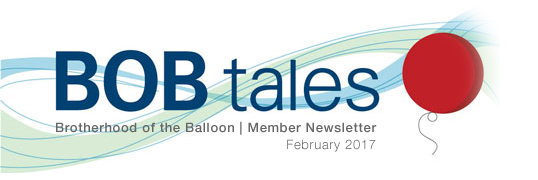

Dear Members:
I don’t like anything that interferes with my exercise routine. I swim three miles/week, run on the treadmill regularly, and lift weights at the gym. I also walk my dog as often as possible. I’m convinced exercise is critical to living a long and healthy life as an important article in this month’s BOB Tales will attest.
About two months ago, I experienced a sharp pain in my right knee along with significant swelling of my knee and calf. After hobbling around the house, losing sleep, and waiting three weeks for an appointment with a sports medicine specialist, I had an X-ray and was immediately scheduled for a venal ultrasound, which ruled out a blood clot … thank God.
An X-ray and MRI revealed a torn medial meniscus and a Baker’s cyst behind my right knee. Surgery was an option for the meniscus tear. I decided to postpone this because my knee pain was beginning to subside. And as many people know, I will go to any length to avoid surgery.
A needle in my knee drained out some fluid and a cortisone injection came next. Physical activity for the next several weeks was severely limited. This caused me great frustration—my exercise routine was interrupted. I quickly realized the truth of the proverb, “You don’t appreciate the water till the well runs dry.” It takes the loss of something to help you appreciate what you had.
Deb and I flew to California in mid-December to attend the retirement celebration for Dr. J. Lynn Martell. During the event, several speakers, including LLUH senior leadership and patients, expressed their appreciation for Lynn’s contributions. They spoke about his impact on LLUCC and their lives. Tributes came in from all over the world. Yours truly was a speaker. I took the opportunity to poke fun at Lynn, which is easy, since he always gave us so much material to work with. I also shared with the group the extraordinary impact Lynn has had on me, personally, as well as the formation and growth of our organization.
Imagining LLUCC without Lynn Martell is hard for me. We became instant friends 16 years ago while I was in treatment. We’ve been best friends ever since. Having said that; I’ve learned that no one is irreplaceable. Someone will take over Lynn’s responsibilities. But it won’t be the same. Once again, “You don’t appreciate the water till the well runs dry.”
While Deb and I were boarding the plane in Boston to fly to Loma Linda, my cell phone rang. It was one of our members, also a good friend. He couldn’t make it to Lynn’s event because of a schedule conflict, and he asked if I would do him a favor. “Sure,” I said.
He said he was going to overnight a check to our hotel in California and asked if I would present it to LLUH President Dr. Richard Hart at the retirement party. “Absolutely,” I said. “What’s the size of the check?” I asked. His answer left me speechless: “One million dollars.”
Read more about this, including who made the gift, in this month’s BOB Tales. As always, we welcome and encourage your feedback and suggestions to continuously improve our newsletter. Just send an email to Deb Hickey.
Bob Marckini
To print the BOB Tales newsletter or view the newsletter with a larger font size, click here for the PDF file.
In This Issue:
- Anticancer Series Part IV: The Mind-Body Connection
- Netflix’s “Food Choices”: A New Documentary the Food Industry Doesn’t Want You to See
- Testosterone Supplements: To Take or Not to Take
- Event Recap: Dr. Lynn Martell’s Retirement Celebration
- Alzheimer’s and Diet: The Link between the Two
- Surviving Cold and Flu Season: Myths and Proper Remedies
- An Easy Way to Extend Your Life: What one thing can you do to cut your risk of colon cancer by 60 percent, recurrent breast cancer by 50 percent, Alzheimer’s by 40 percent, heart disease by 40 percent, type II diabetes by 58 percent and stroke by 27 percent?
.jpg)
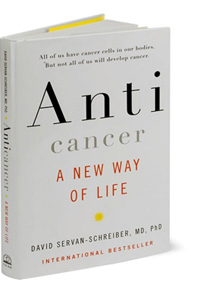 Anticancer Series Part IV: The Mind Body Connection
Anticancer Series Part IV: The Mind Body Connection
In October, we began a series of articles on the book, Anticancer: A New Way of Life by David Servan-Schreiber, MD, PhD. This series is being authored by BOB member, Pat Greany, PhD, retired USDA research entomologist and courtesy professor at the University of Florida.
In this final installment, we’ll discuss two topics that are increasingly gaining attention as additional ways to reduce our susceptibility to cancer and to inhibit further development or even promote regression.
Dr. Servan-Schreiber
Dr. Servan-Schreiber (Dr. S-S) was a 31-year-old neuro-psychiatrist and scientist/researcher who accidentally discovered he had a deadly brain tumor. In his journey to stay alive, Dr. S-S set out to learn everything he could about the causes of cancer and how to combat cancer through diet and lifestyle changes. His findings are nothing less than shocking, and Anticancer has become the best-selling book about cancer in the world. Here is the final article in our series on this important book.
Stress Reduction
In previous installments, we focused on diet and the environment, but Dr. S-S also recognized the importance of the “Anticancer Mind” and the “Anticancer Body.” He provides guidance, based partly upon his own experience and that of his patients, as how to improve our health, for example by reducing stress. He speaks about the mind-body connection and references studies, including one published in Science, that show the influence of psychological trauma on tumor development. Dr. S-S indicates that there is a new field called “psychoneuroimmunology,” which shows that stress can lead to the release of hormones (adrenalin and cortisol) that “in turn activate the nervous system, accelerating heart rate, raising blood pressure, and tensing 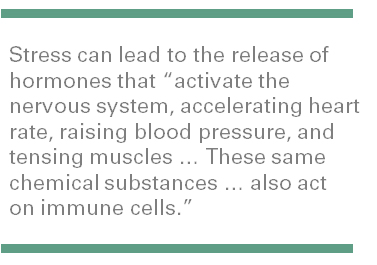 muscles so they will be prepared to make an effort or stave off attack.” He states, “These same chemical substances that activate the neurological and visceral reflexes of stress also act on immune cells. White blood cells have receptors on their surface that detect the presence of stress hormones and react according to fluctuations in the levels of these hormones in the bloodstream. Some of these cells respond by releasing inflammatory cytokines and chemokines.”
muscles so they will be prepared to make an effort or stave off attack.” He states, “These same chemical substances that activate the neurological and visceral reflexes of stress also act on immune cells. White blood cells have receptors on their surface that detect the presence of stress hormones and react according to fluctuations in the levels of these hormones in the bloodstream. Some of these cells respond by releasing inflammatory cytokines and chemokines.”
“Natural killer cells are blocked by noradrenaline and cortisol, remaining passive, glued to the walls of blood vessels rather than attacking viruses or abnormal precursor cancer cells.” He introduces the concept of “mindfulness meditation” (p. 169) and cites an example of a prostate cancer patient who saw marked improvement in a number of inflammation-related biomarkers after he began meditating (p. 170). So, the mind-body connection is well-established and needs to be taken into account in dealing with cancer. It would seem that almost anything we can do to reduce inflammation would be in our interest, so long as the anti-inflammatory agent is not harmful.
Physical Activity
Along with stress reduction is the role of exercise as it affects the “Anticancer Body” (Chapter 11). Dr. S-S presents a number of examples of patients who benefited from adopting an exercise regimen, even while undergoing chemotherapy. He indicates that “physical exercise modifies our hormonal balance. It reduces the excess estrogens and testosterone that stimulate the growth of cancers … Exercise also reduces blood sugar levels and, as a
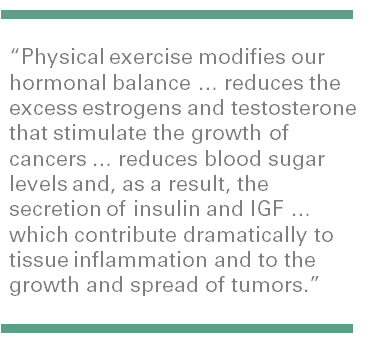
result, the secretion of insulin and IGF … which contribute dramatically to tissue inflammation and to the growth and spread of tumors. Physical exercise even acts directly on the cytokines responsible for inflammation by lowering their level in the blood. Physical activity has a direct effect on the immune system, seemingly protecting it against the stress of bad news” (p. 198).
A study in the J. Clinical Oncology reported a 50-60 percent drop in the relapse rate after breast cancer treatment with exercise! Other studies he cites showed up to a 70 percent reduction in the risk of death from prostate cancer in men over 65 as a benefit from regular exercise (p. 201)! By combining dietary improvements and exercise, research has shown that breast cancer patients were able to reduce their risk of relapse by almost half (p. 220)!
A summary of the entire Anticancer action program is provided in the book as a removable 16-page insert, illustrating cancer-promoting and cancer-deterring agents and approaches, including lifestyle changes. It also provides graphical data indicating the relative cancer cell growth inhibition (in vitro) properties of various plants. This insert alone is worth the cost of the book!

Dr. S-S initiated the “Anticancer Lifestyle Program” at MD Anderson, which is led by Dr. Lorenzo Cohen (an advisor to the producers of the film, “The C Word,” mentioned in a previous BOB Tales). The evidence-based lifestyle transformation program provides cancer survivors with the essential tools and information necessary to make and sustain changes in the areas of diet, fitness, stress management, and exposure to toxins in daily life.
The tenets of Anticancer living include six pillars of health that are linked with cancer risk and/or influence outcomes for those with cancer:
- Diet
- Physical activity
- Stress management
- Sleep
- Love and support
- Environmental toxins
Learn more about the Anticancer lifestyle. We also encourage you to read Anticancer: A New Way of Life.
On behalf of the BOB, I encourage you all to live well and prosper! Best wishes for 2017! —Patrick Greany, PhD

Netflix’s “Food Choices”
BOB member, Pat Greany, PhD, retired USDA research entomologist, courtesy professor at the University of Florida, and author of our Anticancer series, sent us a message last month after he watched a ground-breaking documentary called “Food Choices” on Netflix. The film explores the impact that food choices have on our health and our planet. It also uncovers misconceptions about food and diet. Twenty-eight world-renowned experts, including Dr. T. Colin Campbell, author of The China Study, are interviewed.
Pat told us, “I’m not ready to adopt an entirely vegetarian diet, but I’m moving in that direction.” He eats eggs, but they’re from free-range, organically-fed chickens. “And despite the argument against fish oil in the film, I buy Nordic Naturals fish oil for EPA and DHA.” Pat also told us he eats as little sugar and white flour products as possible, but admitted it’s hard to give up grains.
“I’ve almost made it to 73 and figure from here on, life is a bonus,” said Pat. “I want to enjoy my remaining years and enjoy food, so I’m not ready to give up everything tasty in the hope of living slightly longer. But I do have a problem with animals being raised and slaughtered under disgusting conditions to save a buck! This film had an impact on me.”
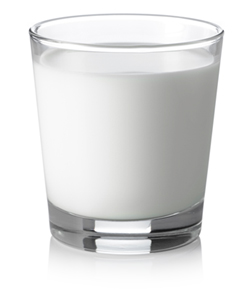
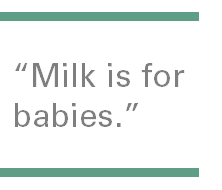 Deb Hickey watched the film after Pat’s suggestion. “I was enlightened,” she said. “One of the biggest myths that has been floating around in my head for 40 years has been that ‘the best’ protein comes from animals. I don’t eat red meat, but always thought I needed chicken in my diet for protein. Apparently, I was wrong. In fact, not only do we not need as much protein as we think we do, too much protein from animals can cause kidney disease and even cancer.”
Deb Hickey watched the film after Pat’s suggestion. “I was enlightened,” she said. “One of the biggest myths that has been floating around in my head for 40 years has been that ‘the best’ protein comes from animals. I don’t eat red meat, but always thought I needed chicken in my diet for protein. Apparently, I was wrong. In fact, not only do we not need as much protein as we think we do, too much protein from animals can cause kidney disease and even cancer.”
According to the film, milk isn’t necessarily the best source for calcium either (try an orange), and we don’t need as much calcium as we are often told. One expert said, “Milk is for babies. It has never been a problem to have too little calcium in the diet … Milk is a cocktail of growth hormones.” Another expert noted that milk is associated with increased risk of prostate cancer.
“This film will absolutely change the way you look at food,” Deb said.
Testosterone Supplements: To Take or Not to Take
A question members often ask is, “Do any members take testosterone supplements after prostate cancer treatment? And, if so, is it safe?”
In addressing this question, we must remind you that we are not physicians and cannot give medical advice. We can tell you only what we have heard or read on this subject.
There seems to be differing opinions among physicians on this issue. Some say that testosterone can promote prostate cancer growth and should never be taken after prostate cancer treatment. Others say, five to 10 years after treatment, men may begin taking testosterone supplements, but they should continue to monitor their PSA closely. One oncologist we spoke with supports this practice, but also suggests that men maintain testosterone levels in the lower half of the normal range.
One of our members wrote to us recently on this subject. He said he was treated 12 years ago and his PSA reached a nadir of 0.6 and stayed there for several years. Last year, as a result of a physical, he learned that he had some bone loss. His urologist recommended a testosterone supplement. Two months later his PSA rose to 0.9 ng/mL. And at four months it was 1.2 (double his nadir). He stopped the testosterone and his PSA came back down.
We spoke with an oncologist about this and he wasn’t surprised with the outcome. This particular doctor is opposed to taking testosterone after prostate cancer treatment.
Bottom line: The jury is out on whether or not it’s safe to take testosterone supplements after prostate cancer treatment. It might make sense, however, to fail on the safe side and avoid testosterone supplements.
We encourage you to talk with both your urologist and your oncologist if you are considering taking testosterone supplements.
Support Group Goes Way Above and Beyond
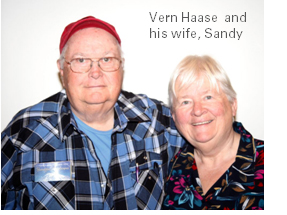 BOB member Vern Haase was diagnosed with prostate cancer in 2010 at the age of 72. His PSA was 4.4, Gleason 6, and he had an enlarged prostate. His urologist told him to “wait and watch,” which made Vern uncomfortable. “I got a second opinion,” Vern said.
BOB member Vern Haase was diagnosed with prostate cancer in 2010 at the age of 72. His PSA was 4.4, Gleason 6, and he had an enlarged prostate. His urologist told him to “wait and watch,” which made Vern uncomfortable. “I got a second opinion,” Vern said.
While in Arizona for the winter, Vern found a copy of Bob Marckini's book, You Can Beat Prostate Cancer: And You Don’t Need Surgery To Do It, in a barbershop (!). He also spoke with a friend who told him, “Don’t do anything about your prostate cancer until you talk to me.” Vern’s friend had been treated with proton therapy at Loma Linda University Cancer Center a year earlier.
After reading Bob’s book and speaking with his friend, Vern knew what he wanted to do. He first took Finasteride to reduce the size of his prostate; he was then treated with proton therapy in the fall of 2012. Vern told us, “I have been pleased with my treatment and care at LLUCC.”
Talk About “Paying it Forward!”
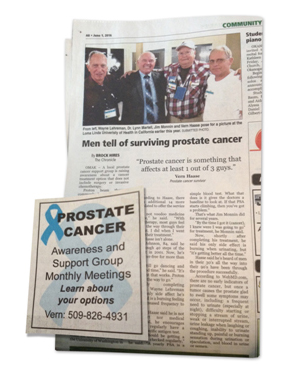 A year later, Vern got together with a fellow “proton graduate” to start a local prostate cancer support group in Omak, WA. Both decided, after having wonderful treatment experiences, they wanted to “pay it forward” and help others. Vern’s wife, Sandy, helps out too. In our opinion, they have gone way beyond “paying it forward” with their efforts. Here is a list of some of the things this group does:
A year later, Vern got together with a fellow “proton graduate” to start a local prostate cancer support group in Omak, WA. Both decided, after having wonderful treatment experiences, they wanted to “pay it forward” and help others. Vern’s wife, Sandy, helps out too. In our opinion, they have gone way beyond “paying it forward” with their efforts. Here is a list of some of the things this group does:
- Meet once a month with former proton patients, prospective proton patients, family members, and caregivers (some drive over 80 miles to attend)
- Post announcements about their meetings in the community calendar section of local area newspapers
- Engage with local newspapers to run stories about proton therapy
- Write letters to editors of various newspapers to promote proton therapy
- Contact radio stations to suggest/arrange programs about proton therapy
- Create posters and flyers about proton therapy to be displayed at doctors’ offices and exam rooms
- Create (5,000!) “business cards” for members to hand out at their leisure
- Buy and place several of Bob Marckini’s book, You Can Beat Prostate Cancer: And You Don’t Need Surgery To Do It, in medical clinics, pharmacies, barber shops, and other businesses within a 40-mile radius
What’s Next?
Vern has helped many find their way to proton treatment. The group is open to new ideas to further awareness about proton therapy and encourage other BOB members to launch local support groups. “I’d be glad to talk to anyone and help them get started,” Vern told us. “It is rewarding and my privilege to serve in this small way to promote proton therapy and Loma Linda University Cancer Center.”
Vern can be reached at [email protected] or 509-826-4931.
Do you belong to a prostate cancer support group? Have you spoken with others about your proton therapy experience? If so, tell us about it!


National Association for Proton Therapy Conference 2017
The National Association for Proton Therapy (NAPT) is the voice of the proton therapy community—providing education and awareness for the public, professional and governmental stakeholders about the benefits of proton therapy for treating cancer. Join the NAPT for the National Proton Conference, March 6 – 9, 2017, at the Renaissance Orlando at SeaWorld in Orlando, FL. Organizers anticipate a record-breaking conference with attendees including physicians, nurses, therapists, proton therapy directors, managers, and others involved with, or interested in learning more about proton therapy.
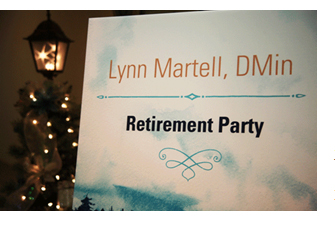 Recap: Retirement Celebration for Dr. Lynn Martell
Recap: Retirement Celebration for Dr. Lynn Martell
Last month, Bob Marckini and Deb Hickey traveled to Loma Linda, CA to join Loma Linda University Health staff, current and former proton therapy patients, BOB members, and friends for a retirement celebration honoring
Dr. Lynn Martell. It was a beautiful tribute to a beloved colleague, an old friend, and the one person who saw the potential of the Brotherhood of the Balloon well before it blossomed into an international organization spanning 39 countries.
Executive Director of Loma Linda University Cancer Center Judy Chatigny served as the MC. Speakers included LLUH president Dr. Richard Hart, Professor and Chair of the Department of Radiation Medicine at LLUCC Dr. Jerry Slater, Director Clinical Operations, Radiation Medicine at LLUCC Yoly Magana, and BOB founder Bob Marckini. Bob used a slide show to poke fun at Lynn, detailing the travels they’ve taken together; Lynn’s “Ready-Fire-Aim” nature; his golfing ability (or lack thereof), and ended with sincere words of appreciation for all that Lynn has done as an associate and a friend to Bob, the Brotherhood of the Balloon and so many others.
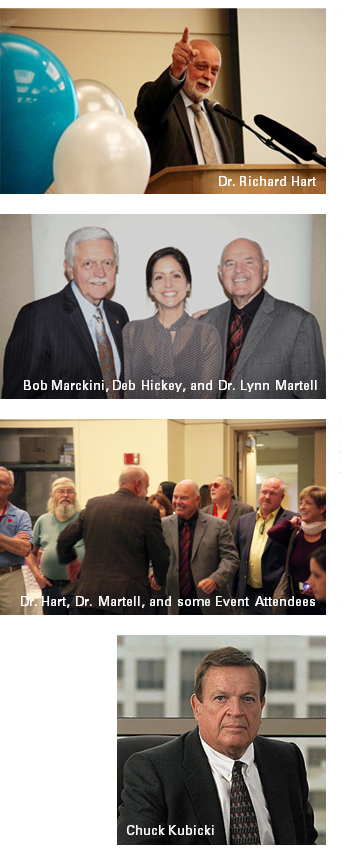 At the end of his presentation, Bob asked Dr. Hart to join him at the stage and said, “A good friend of ours, BOB member, Chuck Kubicki, wished he could be here to honor Lynn today, but had another commitment.” Chuck has been a huge supporter of proton therapy and LLUCC since his successful treatment in 2002. Bob continued, “He asked me to do him a favor.” Bob reached into his pocket and pulled out a check. He presented it to Dr. Hart and said, “Chuck has written a check for $1 million dollars to support Vision 2020 and the proton center at Loma Linda.” The audience gasped. With a big smile on his face, Dr. Hart graciously accepted the check, thanking Chuck for his incredible generosity.
At the end of his presentation, Bob asked Dr. Hart to join him at the stage and said, “A good friend of ours, BOB member, Chuck Kubicki, wished he could be here to honor Lynn today, but had another commitment.” Chuck has been a huge supporter of proton therapy and LLUCC since his successful treatment in 2002. Bob continued, “He asked me to do him a favor.” Bob reached into his pocket and pulled out a check. He presented it to Dr. Hart and said, “Chuck has written a check for $1 million dollars to support Vision 2020 and the proton center at Loma Linda.” The audience gasped. With a big smile on his face, Dr. Hart graciously accepted the check, thanking Chuck for his incredible generosity.
Chuck’s gift will be directed toward proton center upgrades as well as the active beam (pencil beam) scanning project at LLUCC. This is not the first time Chuck has made a substantial gift to LLUCC. It was Chuck who suggested the establishment of the BOB Chair Fund at LLUCC. At that time, he made a sizeable gift to “seed” the fund. It was a challenge gift that matched gifts given by others, effectively doubling contributions by others who participated. The BOB Chair Fund eventually became the Robert J. Marckini Endowed Chair, which is at more than $2.5 million and is funding important proton therapy research. Chuck, we are forever grateful to you and thankful for your continued generosity.
Former proton patients and BOB members, Scott Wilcox, Steve Cohan, and Dr. Terry Wepsic ended Lynn’s retirement celebration, each speaking about Lynn’s impact on their personal lives. We should note that Dr. Wepsic entered the room dressed as Santa Claus, which brought cheers and laughs to the celebration.
Lynn, we believe you have raised LLUH’s mission to “Make Man Whole” to a new level. You’ve made a mark on the institution that will never fully disappear. In honor of the lives you have touched, below are just a handful of the many messages that passed through our inboxes over the last month in response to the Dec/Jan BOB Tales newsletter announcing your retirement:
Lynn: You are proof that there are angels on earth. Your compassion and thoughtfulness for people is remarkable. At 45 years of age, I came to LLUCC a scared little boy. You helped me find the man inside me again … Love from my heart, and as you always say, “Keep looking up.”
Lynn: I am one of the many, many people you have helped through proton therapy at Loma Linda. Though my treatment was nearly 10 years ago, I remember your inspirational, humorous presentations at our Wednesday evening gatherings … You have done a lot of good for so many men and their families. Please accept our appreciation along with our wishes for a long and happy retirement.
When I began treatment at LLUCC, Lynn greeted me with open arms. He helped take away the stress of dealing with a frightening disease. When new patients entered the treatment program, I could see gloom in their faces. Lynn helped turn that around in everyone ... God bless Lynn Martell and the golf cart he rides on!
Lynn: You embody—and indeed are—the USP of Loma Linda! We can all think of past teachers and professors who somehow touched our lives and made a difference. You are one of those. In my case, you were the catalyst that made a classically politically incorrect guy actually think about health and lifestyle in concrete terms—and embrace veganism and a healthy lifestyle. I view this as much of a contribution Loma Linda made to me as it did in treating my cancer. And you provided that little bit of extra spark I needed to take up golf while I was on my radiation vacation.
Lynn was a source of constant encouragement and inspiration while I was being treated at LLUCC. Lynn was key to me adopting a healthier physical lifestyle and my endless journey of running, biking, and swimming. He became a good friend that summer. It all started in June, 2009 with the participation in my first triathlon at the PossAbilities Sprint Triathlon in Loma Linda. This Sunday I will be competing in my 200th competitive event at a 1/2 marathon in Atlanta. This one I will dedicate to Lynn Martell.
We’ll end with these words from Scott Wilcox’s speech:
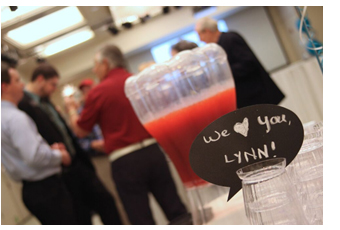 Lynn says, “No one comes to Loma Linda by accident.”… Lynn, you didn’t come to Loma Linda by accident either, and you’ve made thousands of people “whole.” On behalf of every patient (and person) you’ve helped, I wish you good health, much time with your family, great vacations with your new trailer, and most important, God’s continued blessing on your life and that of your family.
Lynn says, “No one comes to Loma Linda by accident.”… Lynn, you didn’t come to Loma Linda by accident either, and you’ve made thousands of people “whole.” On behalf of every patient (and person) you’ve helped, I wish you good health, much time with your family, great vacations with your new trailer, and most important, God’s continued blessing on your life and that of your family.
I know that one day God will tell you in person the same words Jesus used in Matthew 25:23, “Well done, good and faithful servant.” And on behalf of many, I’d also like to say, well done!
If you would like to contact Lynn and wish him well in his retirement, you can reach him at his new email address: [email protected].

The Difference(s) You are Making
The contributions of our members and friends have helped Loma Linda University Cancer Center reach many milestones over the past few years. Why do we continuously ask our members to contribute to LLUCC and proton research? Below are just a few reasons.
- Proton therapy treatment sites have expanded to 240 parts of the body including the breast, brain, lungs, and tumors wrapped around the spine.
- LLUCC is treating over 200 histologic subtypes of cancer.
- LLUCC treated their 20,000th patient this year.
- The breast cancer trial is in its 3rd phase and has been picked up by other proton centers.
- Hybrid 20-treatment therapy continues to produce promising results with no added side effects.
- LLUCC is preparing to add state-of-the-art Active Beam Scanning/Pencil Beam to allow more precise targeting of certain treatment sites. This technology also allows for the potential of safely delivering higher doses of radiation with fewer treatments. It also provides the potential to expand treatment to non-cancer ailments.
- LLUCC has installed two new cyclotrons that allow them to target proton radiation
- at the cellular level.
- LLUCC has hired additional researchers. The research team includes several physicians, physicists, and biologists.
- LLUCC is researching and running animal trials to treat Atrial Fibrillation of the heart and Arteriovenous Malformation (AVM) of the brain (brain bleed in simple terms). AVM is particularly compelling because it affects young children and may eliminate the need for highly invasive cranial procedures. LLUCC is the only proton center in the country working on AVM.
Clearly, your gifts are making a difference. The funding our group is providing helps researchers study new applications for the proton beam as well as helping physicians and scientists conduct clinical studies to determine better ways to use proton therapy to benefit more patients.
Note: Additional research project partnering with the Department of Defense and the VA treating neurological pain from veteran amputees has been put on hold as the DOD fulfilled their pledge on the project and additional funding is now needed to continue the research.
Please help others have access to the treatment we’ve had the privilege of receiving. The team at LLUCC is grateful for your generosity.

How to Contribute to Proton Research
- Donate Online: Visit the LLUCC website. Make sure the “Designation Type” is set to “Proton” and the “Designation” is set to “Robert J. Marckini Chair."
- Send a Check: Make your check out to “LLUCC Proton” with “Marckini Chair” on the memo line and send to: LLUH, Office of Philanthropy, P.O. Box 2000, Loma Linda, CA 92354.
- Make a Call: Contribute by phone. Contact Elvia DeHaro at 909-558-5010
- Make a Future Gift: Contact Todd Mekelburg at the Office of Planned Giving at Loma Linda University Health at 909-558-5376 or [email protected].
- Other Ways to Give: Contact Matt Miller at the Office of Philanthropy at Loma Linda University Health at 909-558-3582 or [email protected].

The Link between Alzheimer’s and Diet
A study published in the Journal of the American College of Nutrition uncovered how literally mind-numbing the typical Western diet is. Researchers studied the relationship between the eating habits of people in Brazil, Chile, Cuba, Egypt, India, Mongolia, Nigeria, Republic of Korea, Sri Lanka, and the United States and the development of Alzheimer’s disease (AD). They found that switching to a Mediterranean diet (primarily plant-based foods, whole grains, legumes, and nuts, olive oil, herbs and spices instead of salt) cuts your risk of AD in half. And diets low in meat consumption in India, Japan, and Nigeria are associated with an additional 50 percent reduction in AD risk.
It is estimated that as many as 5.1 million Americans may have Alzheimer’s disease. In the U.S. one in nine people 65 and older has Alzheimer’s disease.
You can take steps to protect your brain: Eat 5-9 servings of produce daily; opt for 2-3 servings of fish weekly; eliminate red meats, added sugars and syrups, and processed grains from your diet. An active social life and a strong network of friends may also help prevent Alzheimer’s in later life.
Surviving Cold and Flu Season: Myths and Proper Remedies
.jpg) The common cold’s trademark symptoms include sore throat, runny nose, coughing, sneezing, headache, and body aches. Most people get two or three colds a year (kids get more). The flu comes with the same symptoms, plus fatigue, chills, and fever. So, how can you prevent getting a cold or the flu and what’s the best way to manage symptoms? The Columbus Ohio Dispatch asked a few doctors to help sort out myths and proper remedies:
The common cold’s trademark symptoms include sore throat, runny nose, coughing, sneezing, headache, and body aches. Most people get two or three colds a year (kids get more). The flu comes with the same symptoms, plus fatigue, chills, and fever. So, how can you prevent getting a cold or the flu and what’s the best way to manage symptoms? The Columbus Ohio Dispatch asked a few doctors to help sort out myths and proper remedies:
- Is washing hands really that important? Yes. This is the best way to prevent spreading contagious illnesses. No soap and water? Use hand sanitizer.
- Can you get sick from a flu shot? No. The flu vaccine is a dead protein product.
- Should you push fluids? Yes. Keeping hydrated also reduces headaches and body aches. With a fever, your body needs three times more water.
- What about “sweating it out” through exercise? Light exercise is good for you. It can stimulate your immune system. But exercise should be avoided if you have a high fever or a lot of chest congestion.
- Does chicken soup help? Yes. Soup adds fluids and electrolytes to the body, and acts much like saline spray soothing the throat. Warm fluids also help open up passages.
- Do humidifiers help? Yes. Warm moist air acts like a decongestant.
- Should you demand antibiotics from your doctor? No. Colds and flus are viruses that do not respond to antibiotics. There are, however, antiviral medications that your doctor may prescribe to help shorten your illness.
- Do multi-symptom cold remedies work best? Not necessarily. Why take a cough suppressant if your nose is dripping? Take a medication that fits your symptoms and don’t overmedicate yourself.
- Can you get a cold from going outside with wet hair? No. The reason people get more colds in the winter is because they are inside where viruses can spread quickly.
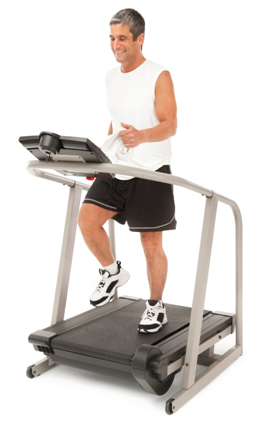 An Easy Way to Extend Your Life
An Easy Way to Extend Your Life
Physical inactivity is the fourth-leading risk factor of death worldwide, ranked right behind blood pressure, tobacco use, and high blood sugar, according to the World Health Organization (WHO). WHO also reported that physical inactivity poses a greater risk of dying than obesity, high cholesterol and alcohol use.
“The good news,” they say, is that “exercise and regular physical activity are directly associated with both longevity and enhanced quality of life.”
According to the American College of Sports Medicine, exercise can benefit us in the following ways:
- Reducing mortality and the risk of recurrent breast
- cancer by 50 percent
- Reduce the risk of colon cancer by over 60 percent
- Reducing the risk of developing Alzheimer’s disease by 40 percent
- Reducing the incidence of heart disease and high blood pressure by 40 percent
- Reducing the risk of stroke by 27 percent
- Reducing the risk of type II diabetes by 58 percent
Most beneficial forms of exercise are simple, inexpensive and enjoyable. Here are a few examples of what you can do:
- Spend five to ten minutes of walking. Challenge yourself to do more walking over time, including multiple walks each day.
- Shoot for 150 minutes of activity each week, including walking, gardening, yard work, or other activities.
- Try to make exercise enjoyable. Exercise with a friend or join a gym.
- Don’t aim for perfection; aim for consistency.
- Keep adding to your exercise program each day, each week. Your body will respond.
- Keep exercise a priority in your life.
- Seek help with your exercise program. Most communities have knowledgeable fitness professionals who can help you with your customized fitness program.
The above was recently reported in Ornish Living.
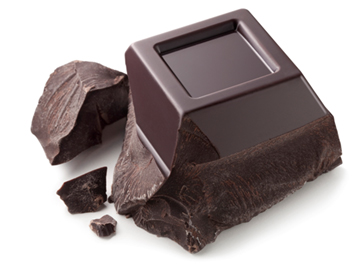 Health Benefits of Cocoa
Health Benefits of Cocoa
Cocoa offers significant health benefits (that can help rationalize the times when you indulge after dinner). It is best to consume high-quality dark chocolate that contains at least 70 percent cocoa, no dairy products, and is made from cocoa butter. Below is a list of some health benefits of cocoa.
- Antioxidant Properties: Believe it or not, cocoa beans contain three times the antioxidants that green tea has and twice the amount found in red wine.
- Natural Antidepressant: Cocoa beans contain enzymes that combat depression. Serotonin, dopamine, and phenylethylamine (PEA) are used by the body to promote positive mental health and a sense of well-being.
- Good for your Heart: Cocoa beans contain polyphenols that are good for the cardiovascular system. This element could reduce blood pressure. Magnesium is another element that is vital to good heart health. Magnesium in cocoa also helps reduce the risk of blood clots (associated with strokes and heart attacks).
- Energy Booster: Having a cup of hot cocoa gives a person the same energy-boosting results as a cup of coffee without the crash that is often experienced after coffee consumption. This is because there are fewer stimulants in cocoa beans than there are in coffee beans.
- Weight Loss: Researchers are studying the effect that cocoa consumption has on improving sensitivity to insulin. Studies are under way that focus on studying the link between obesity and a sensitivity to insulin. Some scientists believe that this connection could help support a person’s efforts to lose weight.
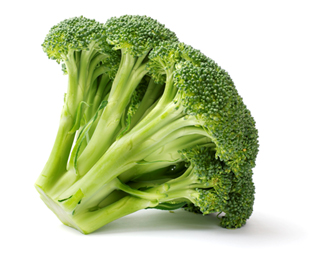
Series: “Make Vegetables Taste Good”
This is the sixth segment on a subject that’s consistent with our Anticancer series. The following recipe was submitted by BOB member spouse Priscilla Goodger. She told us this is one of her favorites.
Deb Hickey made it her mission to find recipes that make the most healthful vegetables something to look forward to at dinnertime. She learned a lot about specific vegetables and how some fight specific health issues while others interact with each other to become “super” foods that target specific cancers. After much research and experimentation, we are happy to share what we’ve learned. And, we are happy to accept and try recipe submissions by our readers. Have a vegetable-based recipe that you find irresistible? Send it to us!
Priscilla’s Parmesan Roasted Broccoli
Preheat oven to 425 degrees.
Ingredients:
- Fresh broccoli florets (12 oz. package)
- 3 garlic cloves
- 5 tbsp avocado or safflower oil, divided
- 1 ½ tsp grated lemon zest
- 1 ½ tsp freshly squeezed lemon juice
- 2 ¼ tbsp pine nuts
- ¼ cup freshly grated parmesan cheese
- Sea salt
- Freshly ground black pepper
Directions:
- Wash and dry broccoli (if cut from crowns, leave an inch or two of stalk attached to the florets). Cut larger pieces through the base
- Place in single layer on jelly roll pan
- Peel and thinly slice garlic. Toss with broccoli.
- Drizzle 4 tbsp oil on broccoli
- Sprinkle sea salt and freshly ground black pepper to taste
- Roast for 20-25 minutes until crisp-tender and the tips of some florets are browned
- Toast pine nuts on low for 5 minutes in dry sauté pan. Toss often.
- Remove from oven and immediately toss with 1 tbsp of oil, grated
lemon zest, lemon juice, toasted pine nuts, parmesan cheese - Serve hot

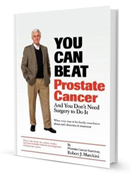
“I Highly Recommend it to Anyone”

I was recently diagnosed with cancer. A friend told me about this book … I learned that prostate cancer is not a death sentence and there are effective cures for the disease … I chose [proton therapy at] Loma Linda University Cancer Center because of Bob’s recommendation and that of a friend who went to LLUCC —Amazon Customer: Tom, November 10, 2016
Please review it. It’ll take a minute out of your day.
If you read Bob’s book and found it helpful in any way, please review it on Amazon. The more reader reviews, the more likely Amazon’s search engine will list the book at the top of the search results when users search for “prostate cancer” and “proton therapy.” Also, the more positive reader reviews, the more likely Amazon will “recommend” the book to readers of other prostate cancer-related books and products.
Buy Online, in Bulk or in Spanish
Online: Paperback: $19.00--•--Kindle: $9.99--•--NOOK Book: $9.99--•--Apple iBook: $9.99
In Bulk: Conctact us for a discount price list. Proceeds from book sales support proton therapy research through the Robert J. Marckini Endowed Chair at LLUCC.
In Spanish: Buy the print version or in eBook format.

Trivia
- Where is the world’s coldest place?
- Where is the world’s most populated city?
- Where is the world’s least populated major city?
- Where is the world’s wealthiest city?
- Where is the world’s poorest city in the poorest country?
Answers are at the end of this section.
Estate Planning Hints
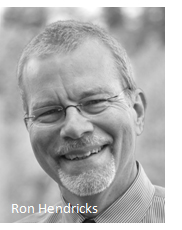 BOB member Ron Hendricks is Director of Gift Planning for Trinity Western University. He regularly copies us on his “News from Ron” mailings, which are helpful hints on estate planning to the readers of his newsletters. We have found Ron’s suggestions to be timely and beneficial. With his permission we periodically share some of his wisdom with our membership. This segment is called Tax-Free Sale.
BOB member Ron Hendricks is Director of Gift Planning for Trinity Western University. He regularly copies us on his “News from Ron” mailings, which are helpful hints on estate planning to the readers of his newsletters. We have found Ron’s suggestions to be timely and beneficial. With his permission we periodically share some of his wisdom with our membership. This segment is called Tax-Free Sale.
Tax-Free Sale
Howard and Lynn were 55 when they purchased land outside of town. They thought it would be a good investment that they could sell for a higher price later.
Over the years, development from town has moved toward the property and their land is next to a large commercial store. They rent the property to the commercial store for overflow parking.
Howard: We have owned this property for over 10 years. It has been a good investment and increased in value. We have received just enough rental income in the past few years to pay the taxes. However, we would like to sell.
Lynn: It would be nice if we could sell without paying a large tax. Our tax advisor has told us that if we were to sell, there would be a large capital gains tax. We also could use some tax deductions this year.
The good news is that Howard and Lynn were able to create a special trust called a charitable remainder unitrust and receive three very nice benefits:
- Bypass capital gain
- Increase income
- Charitable deduction
Howard: We are delighted with our unitrust. We saved about $36,000 in capital gains tax and almost $18,000 in income taxes. That is over $54,000 in tax savings!
Lynn: Plus, we increased our income. The land was producing almost no income before. Now, we receive over $12,000 in income each year. This increased income is one of my favorite parts of the plan.
Trivia Answers:
- East Antarctic Plateau is the world’s coldest place. On the high ridge of the East Antarctic Plateau, the temperature can drop to as low as -135.8 degrees Fahrenheit, which was recorded in August 2010.
- Shanghai is the world’s most populated city. At a whopping 24,150,000 permanent inhabitants, Shanghai is the only place that is home to over 24 million people in one city.
- Vatican City is the world’s least populated major city. With a paltry population of 842, the city-state of Vatican City is the smallest city and state (country) in the world.
- Tokyo, Japan is the world’s wealthiest city. Tokyo tops the charts with a GDP of $1,520 billion, beating New York City by a mere $310 billion.
- Kinshasa is the poorest city in the Democratic Republic of the Congo, which is also the poorest country in the world, at a GDP of $55 billion. Many of its residents live on less than $1 a day.

Last Month’s Brain Teaser
Last month’s brain teaser was an Observation Quiz first sent to us by our friend, the late Ambassador Joseph Verner Reed. There were 20 questions with answers given. The average person typically gets only seven right. We offered a signed copy of Bob’s book to the first person who told us he/she beat Bob and scored 18 or higher.
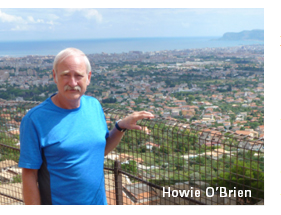 Winner: We received many responses to last month’s teaser. Most had achieved a score of 18, which doesn’t surprise us—our members are smart. The first to write in was Howie O’Brien of Hansville, WA. Howie also answered 18 questions correctly.
Winner: We received many responses to last month’s teaser. Most had achieved a score of 18, which doesn’t surprise us—our members are smart. The first to write in was Howie O’Brien of Hansville, WA. Howie also answered 18 questions correctly.
Howie told us he’s doing “very well” since his proton treatment in 2012. “My wife and I travel extensively and I am still pursuing all the activities I enjoyed before treatment.” Howie also told us he educates others about proton therapy for prostate cancer whenever he has a chance.
The photo on the left shows Howie on a recent trip to Sicily.
New Brain Teaser: Observation Quiz
What is the longest word in the English language?
Note: There are multiple answers to this question. The first with any one of the correct answers will be the winner and receive a signed copy of Bob’s book.
Send your answer to [email protected]. As always, we will announce the winner in next month’s issue of BOB Tales.
Hearing Loss
An old man was wondering if his wife had a hearing problem. So one night, he stood behind her while she was sitting in her lounge chair. He spoke softly to her, “Honey, can you hear me?” There was no response, so he moved a little closer and spoke again, “Honey, can you hear me?” Still, there was no response. Finally, he moved right behind her and yelled, “Honey! Can you hear me?”
Sounding annoyed, she replied, “For the third time, YES!”
Growing Older
I just spent 15 minutes searching for my iPhone in my car … using my iPhone as a flashlight.
I don’t understand how I can remember every word of a song from 1964, but can’t remember why I walked into the kitchen?
I’m at an age when my back goes out more than I do.
Super Bowl Tickets
A friend of mine has two tickets for the 2017 Super Bowl, both box seats. He paid $1,700 for each ticket. He didn’t realize when he bought them that this was going to be on the same day as his wedding, so now he can’t go.
If you are interested and would like to go in his place, it’s at St Peter’s Church in New York City at 5 pm. Her name is Nancy. She’s 5’4,” about 115 lbs., good cook, makes $90,000 a year! She will be the one in the white dress.

Quote of the Month:
“Logic will get you from A to B. Imagination will take you everywhere.” —Albert Einstein


Prayer Could be Good Medicine
A Flashback to our April 2003 BOB Tales
On Sunday, March 23, 2003, Parade Magazine featured an article entitled, “Why Prayer Could Be Good Medicine.” The article referenced numerous studies, which have shown that people who pray regularly stay healthier and live longer than those who rarely or never do.
A Duke University study involving 4,000 people of various faiths found that the relative risk of dying (at a younger age) was 46 percent lower for those who frequently attended religious services. Prayer has been found to improve the quality, if not the quantity of life. “It boosts morale, lowers agitation, loneliness and life dissatisfaction, and enhances the ability to cope in men, women, the elderly, the young, the healthy, and the sick.”
Other studies showed that prayer helped reduce blood pressure and strengthen the immune system. No one seems to fully understand the mechanism by which this all happens, but the data certainly suggest that prayer is beneficial.
If a prayer can promote healing in us, then why not in our troubled world? Parade Magazine asked the distinguished spiritual teacher Rabbi Harold Kushner to compose a prayer that can be said by anyone of any faith. It is a beautiful prayer and we thought we would share it with you:
A Prayer for the World:
Let the rain come and wash away the ancient grudges, the bitter hatreds held and nurtured over generations. Let the rain wash away the memory of hurt and neglect. Then let the sun come out and fill the sky with rainbows. Let the warmth of the sun heal us wherever we are broken. Let it burn away the fog so that we can see each other clearly so that we can see beyond labels, beyond accents, gender, or skin color. Let the warmth and brightness of the sun melt our selfishness so that we can share the joys and feel the sorrows of our neighbors. And let the light of the sun be so strong that we will see all people as our neighbors. Let the earth, nourished by rain, bring forth flowers to surround us with beauty. And let the mountains teach our hearts to reach upward to heaven. Amen.
Low PSAs to all,
Bob Marckini and Deb Hickey
To print the BOB Tales newsletter or view the newsletter with a larger font size, click here for the PDF file.
NO MEDICAL ADVICE: Material appearing here represents opinions offered by non-medically-trained laypersons. Comments shown here should NEVER be interpreted as specific medical advice and must be used only as background information when consulting with a qualified medical professional.
